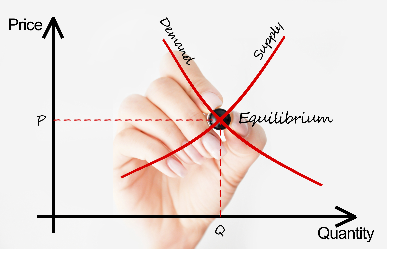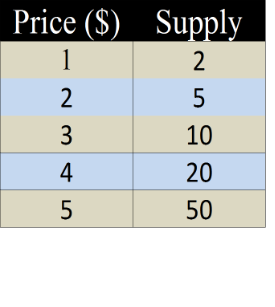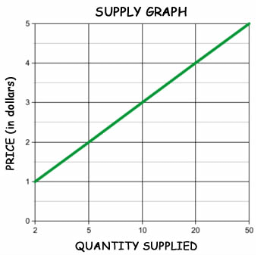Supply
We now need to think like a business owner. We are no longer the consumer (as we were when we studied demand); we are now the producer and supplier of goods and services.
Supply is the amount of a product that would be offered for sale at all possible prices in the market. That means the amount a producer will offer when the price is: $1, $2, $5, $100, $1000, etc.
The Law of Supply states that suppliers will normally offer more for sale at higher prices and less at lower prices. Remember we are now the ones who are creating the goods and services. In a market economy, it is only natural that we are willing to supply more of a product when the price for which it is selling is higher.
Supply Curves
A supply curve is a graph which shows the amount a producer will make varies depending on the price that consumers will pay. This is a graphic representation of how much customers are willing to pay.
To learn more about the supply curve, watch Supply Graph (1:07).

An individual supply curve illustrates how the quantity that a producer will make varies depending on the price that will prevail in the market
For example, how many cans of Coca-Cola will sell at all possible prices?

A market supply curve illustrates the quantities and prices that all producers will offer in the market for any given product or service.
For example, how many cans of soft drinks of any brand will sell at all possible prices?

Supply Schedule
Economists analyze supply by listing quantities and prices in a supply schedule. A supply schedule is a representation of the supply graph in the form of a table.

Supply Graph
When the supply data is graphed, it forms a supply curve with an upward slope. This is a graphic representation of the data provided from the supply schedule.


Elasticity of Supply
Elasticity is determined by how responsive supply is to changes in price.
• Supply is elastic when a small increase in price leads to a larger increase in output.
• Supply is inelastic when a large increase in price causes little change in supply.
• Supply is unit elastic when a change in price causes a proportional change in supply.
Determinants of Elasticity of Supply
Determinants of supply elasticity are related to how quickly a producer can act when the change in price occurs.
If adjusting production can be done quickly, the supply is elastic. If production is complex and requires much advance planning, the supply is inelastic.
Another factor is substitution. If substitution is easy, the supply is elastic. If substitution is difficult, the supply is inelastic.